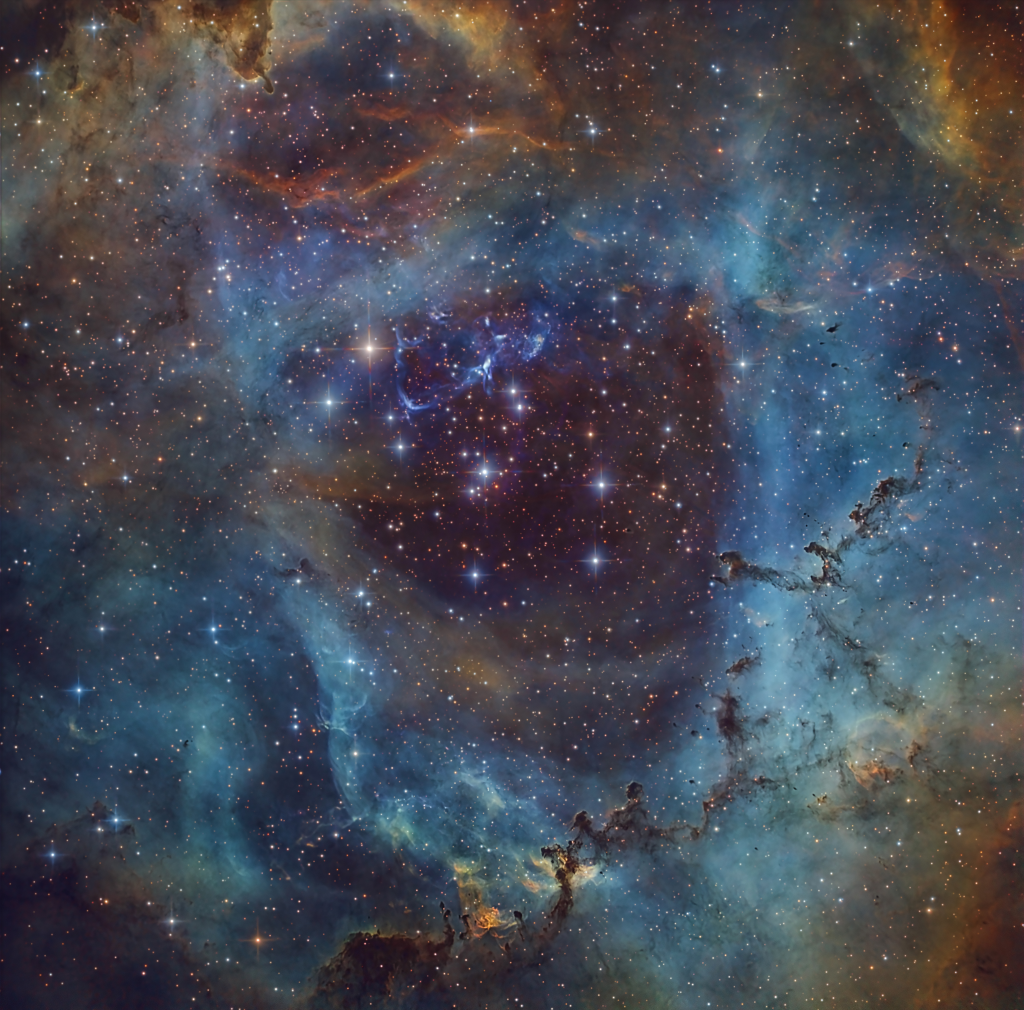
Nombre total de pages vues
09/02/2024
SANTé/MEDECINE - Tchernobyl a-t-il produit des monstres ?

LE JARDIN MERVEILLEUX DES EPICES - La vanille, une épice aux saveurs de l’enfance

ASTRONOMY - When Roses Aren't Red
2024 February 9
Image Credit & Copyright: Tommy Lease (Denver Astronomical Society)
Explanation: Not all roses are red of course, but they can still be very pretty. Likewise, the beautiful Rosette Nebula and other star forming regions are often shown in astronomical images with a predominately red hue, in part because the dominant emission in the nebula is from hydrogen atoms. Hydrogen's strongest optical emission line, known as H-alpha, is in the red region of the spectrum. But the beauty of an emission nebula need not be appreciated in red light alone. Other atoms in the nebula are also excited by energetic starlight and produce narrow emission lines as well. In this close-up view of the Rosette Nebula, narrowband images are mapped into broadband colors to show emission from Sulfur atoms in red, Hydrogen in green, and Oxygen in blue. In fact, the scheme of mapping these narrow atomic emission lines (SHO) into the broader colors (RGB) is adopted in many Hubble images of emission nebulae. This image spans about 50 light-years across the center of the Rosette Nebula. The nebula lies some 3,000 light-years away in the constellation Monoceros.
08/02/2024
LE JARDIN MERVEILLEUX DES EPICES - Le safran l’une des épices les plus chères au monde

SANTE/MEDECINE - L'oeil : la vision au-delà de la vision

ASTRONOMY - Globular Star Cluster 47 Tuc
2024 February 8
Image Credit & Copyright: Marco Lorenzi, Angus Lau, Tommy Tse
Explanation: Globular star cluster 47 Tucanae is a jewel of the southern sky. Also known as NGC 104, it roams the halo of our Milky Way Galaxy along with some 200 other globular star clusters. The second brightest globular cluster (after Omega Centauri) as seen from planet Earth, 47 Tuc lies about 13,000 light-years away. It can be spotted with the naked-eye close on the sky to the Small Magellanic Cloud in the constellation of the Toucan. The dense cluster is made up of hundreds of thousands of stars in a volume only about 120 light-years across. Red giant stars on the outskirts of the cluster are easy to pick out as yellowish stars in this sharp telescopic portrait. Tightly packed globular cluster 47 Tuc is also home to a star with the closest known orbit around a black hole.
07/02/2024
LE JARDIN MERVEILLEUX DES EPICES - Le poivre une épice aux mille couleurs

06/02/2024
SANTé/MEDECINE - Espoir : Vers une approche moléculaire des cancers

ASTRONOMY - NGC 1566: A Spiral Galaxy from Webb and Hubble
2024 February 6
Image Credit & Copyright: NASA, ESA, CSA, STScI, J. Lee (STScI), T. Williams (Oxford), R. Chandar (UToledo), D. Calzetti (UMass), PHANGS Team
Explanation: What's different about this galaxy? Very little, which makes the Spanish Dancer galaxy, NGC 1566, one of the most typical and photogenic spirals on the sky. There is something different about this galaxy image, though, because it is a diagonal combination of two images: one by the Hubble Space Telescope on the upper left, and the other by the James Webb Space Telescope on the lower right. The Hubble image was taken in ultraviolet light and highlights the locations of bright blue stars and dark dust along the galaxy's impressive spiral arms. In contrast, the Webb image was taken in infrared light and highlights where the same dust emits more light than it absorbed. In the rollover image, the other two sides of these images are revealed. Blinking between the two images shows which stars are particularly hot because they glow brighter in ultraviolet light, and the difference between seemingly empty space and infrared-glowing dust.
SANTé/MEDECINE - CANCER - 12 AVANCEES REVOLUTIONNAIRES - 7. Des biopsies liquides et synthétiques moins invasives et plus rapides
Les biopsies classiques nécessitent le prélèvement de tissu, souvent par chirurgie. Aujourd’hui, la biopsie liquide offre une alternative pl...

-
2022 September 26 All the Water on Planet Earth Illustration Credit: Jack Cook, Adam Nieman, Woods Hole Oceanographic Institution ; Data ...
-
2025 May 11 The Surface of Venus from Venera 14 Image Credit: Soviet Planetary Exploration Program , Venera 14 ; Processing & Copyri...




